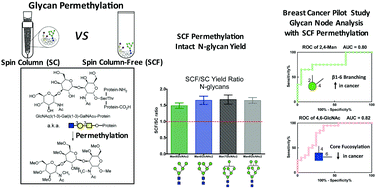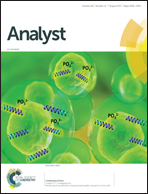A spin column-free approach to sodium hydroxide-based glycan permethylation†
Abstract
Glycan permethylation was introduced as a tool to facilitate the study of glycans in 1903. Since that time, permethylation procedures have been continually modified to improve permethylation efficiency and qualitative applicability. Typically, however, either laborious preparation steps or cumbersome and uneconomical spin columns have been needed to obtain decent permethylation yields on small glycan samples. Here we describe a spin column-free (SCF) glycan permethylation procedure that is applicable to both O- and N-linked glycans and can be employed upstream to intact glycan analysis by MALDI-MS, ESI-MS, or glycan linkage analysis by GC-MS. The SCF procedure involves neutralization of NaOH beads by acidified phosphate buffer, which eliminates the risk of glycan oxidative degradation and avoids the use of spin columns. Optimization of the new permethylation procedure provided high permethylation efficiency for both hexose (>98%) and HexNAc (>99%) residues—yields which were comparable to (or better than) those of some widely-used spin column-based procedures. A light vs. heavy labelling approach was employed to compare intact glycan yields from a popular spin-column based approach to the SCF approach. Recovery of intact N-glycans was significantly better with the SCF procedure (p < 0.05), but overall yield of O-glycans was similar or slightly diminished (p < 0.05 for tetrasaccharides or smaller). When the SCF procedure was employed upstream to hydrolysis, reduction and acetylation for glycan linkage analysis of pooled glycans from unfractionated blood plasma, analytical reproducibility was on par with that from previous spin column-based “glycan node” analysis results. When applied to blood plasma samples from stage III–IV breast cancer patients (n = 20) and age-matched controls (n = 20), the SCF procedure facilitated identification of three glycan nodes with significantly different distributions between the cases and controls (ROC c-statistics > 0.75; p < 0.01). In summary, the SCF permethylation procedure expedites and economizes both intact glycan analysis and linkage analysis of glycans from whole biospecimens.



 Please wait while we load your content...
Please wait while we load your content...